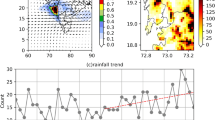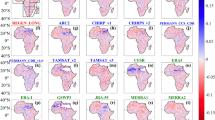Abstract
The study evaluated CORDEX RCMs’ ability to project future rainfall and extreme events in the Mzingwane catchment using an ensemble average of three RCMs (RCA4, REMO2009 and CRCM5). Model validation employed the statistical mean and Pearson correlation, while trends in projected rainfall and number of rainy days were computed using the Mann-Kendall trend test and the magnitudes of trends were determined by Sen’s slope estimator. Temporal and spatial distribution of future extreme dryness and wetness was established by using the Standard Precipitation Index (SPI). The results show that RCMs adequately represented annual and inter-annual rainfall variability and the ensemble average outperformed individual models. Trend results for the projected rainfall suggest a significant decreasing trend in future rainfall (2016–2100) for all stations at p < 0.05. In addition, a general decreasing trend in the number of rainy days is projected for future climate, although the significance and magnitude varied with station location. Model results suggest an increased occurrence of future extreme events, particularly towards the end of the century. The findings are important for developing proactive sustainable strategies for future climate change adaption and mitigation.







Similar content being viewed by others
References
Akinsanola K, Ogunjobi I, Ajayi V (2015) Assessing capabilities of three regional climate models over CORDEX AFRICA in simulating West African summer monsoon precipitation
Barros D, Albernaz A (2014) Possible impacts of climate change on wetlands and its biota in the Brazilian Amazon. Braz J Biol 74:810–820. https://doi.org/10.1590/1519-6984.04013
Bremner J (2017) Population, food security and climate change, in: Africa’s population. In Search of a Demographic Dividend
Burkett V, Kusler J (2000) Climate change: potential impacts and interactions in wetlands of the United States 1. Wiley Online Library
Carrington DP, Gallimore RG, Kutzbach JE (2001) Climate sensitivity to wetlands and wetland vegetation in mid-Holocene North Africa. Clim Dyn 17:151–157
Carson M, Köhl A, Stammer D, Slangen ABA, Katsman CA, van de Wal RSW, Church J, White N (2016) Coastal sea level changes, observed and projected during the 20th and 21st century. Clim Chang 134:269–281. https://doi.org/10.1007/s10584-015-1520-1
Change IC (2013) The physical science basis. Working Group I Contribution to the Fifth Assessment Report of the Intergovernmental Panel on Climate Change. Camb. U. K. N. Y. USA
Chenje M, Sola L, Palencny D (eds) (1998) The state of Zimbabwe’s environment. Ministry of Mines, Environment and Tourism, Harare
Dosio A, Panitz H-J (2016) Climate change projections for CORDEX-Africa with COSMO-CLM regional climate model and differences with the driving global climate models. Clim Dyn 46:1599–1625. https://doi.org/10.1007/s00382-015-2664-4
FAO (2010) Global Forest Resources Assessment 2010
Görgens AHM, Boroto RA (1997) Limpopo River: flow balance anomalies, surprises and implications for integrated water resources management. Proc. 8th South Afr. Natl. Hydrol. Symp
Hamed KH, Rao AR (1998) A modified Mann-Kendall trend test for autocorrelated data. J Hydrol 204:182–196
Hansen J, Sato M, Hearty P, Ruedy R, Kelley M, Masson-Delmotte V, Russell G, Tselioudis G, Cao J, Rignot E, Velicogna I, Tormey B, Donovan B, Kandiano E, von Schuckmann K, Kharecha P, Legrande AN, Bauer M, Lo K-W (2016) Ice melt, sea level rise and superstorms: evidence from paleoclimate data, climate modeling, and modern observations that 2 °C global warming could be dangerous. Atmos Chem Phys 16:3761–3812. https://doi.org/10.5194/acp-16-3761-2016
Hulme M, Doherty R, Ngara T, New M, Lister D (2001) African climate change: 1900-2100. Clim Res 17:145–168
IPCC - Intergovernmental Panel on Climate Change (2007) [WWW Document]. URL https://www.ipcc.ch/publications_and_data/publications_ipcc_fourth_assessment_report_synthesis_report.htm (accessed 7.18.16)
IPCC (2014) Climate Change 2014: Synthesis report. contribution of working groups I, II and III to the fifth assessment report of the intergovernmental panel on climate change. In core writing team, Pachauri RK and Meyer LA (eds). IPCC, Geneva, pp 151
Kalognomou E-A, Lennard C, Shongwe M, Pinto I, Favre A, Kent M, Hewitson B, Dosio A, Nikulin G, Panitz H-J, Büchner M (2013) A diagnostic evaluation of precipitation in CORDEX models over Southern Africa. J Clim 26:9477–9506. https://doi.org/10.1175/JCLI-D-12-00703.1
Kruger AC, Nxumalo M (2017) Surface temperature trends from homogenized time series in South Africa: 1931-2015: temperature trends in South Africa: 1931-2015. Int J Climatol 37:2364–2377. https://doi.org/10.1002/joc.4851
Kruger AC, Sekele SS (2013) Trends in extreme temperature indices in South Africa: 1962-2009. Int J Climatol 33:661–676. https://doi.org/10.1002/joc.3455
Kruger AC, Shongwe S (2004) Temperature trends in South Africa: 1960–2003. Int J Climatol 24:1929–1945
Lamsal P, Kumar L, Atreya K, Pant KP (2017) Vulnerability and impacts of climate change on forest and freshwater wetland ecosystems in Nepal: a review. Ambio 46:915–930. https://doi.org/10.1007/s13280-017-0923-9
Love D, Uhlenbrook S, Twomlow S, van der Zaag P (2010) Changing hydroclimatic and discharge patterns in the northern Limpopo Basin, Zimbabwe. Water SA 36:335–350
Luhunga P, Botai J, Kahimba F (2016) Evaluation of the performance of CORDEX regional climate models in simulating present climate conditions of Tanzania. J South Hemisphere Earth Syst Sci 66:32–54. https://doi.org/10.22499/3.6601.005
Manatsa D, Chingombe W, Matarira CH (2008) The impact of the positive Indian Ocean dipole on Zimbabwe droughts. Int J Climatol 28:2011–2029. https://doi.org/10.1002/joc.1695
McKee TB, Doesken NJ, Kleist J et al (1993) The relationship of drought frequency and duration to time scales. In: Proceedings of the 8th Conference on Applied Climatology. American Meteorological Society Boston, MA, p 179–183
Meque A, Abiodun BJ (2015) Simulating the link between ENSO and summer drought in Southern Africa using regional climate models. Clim Dyn 44:1881–1900. https://doi.org/10.1007/s00382-014-2143-3
Mutayoba E, Kashaigili JJ (2017) Evaluation for the performance of the CORDEX regional climate models in simulating rainfall characteristics over Mbarali River catchment in the Rufiji Basin, Tanzania. J Geosci Environ Prot 5:139–151. https://doi.org/10.4236/gep.2017.54011
Nikulin G, Jones C, Giorgi F, Asrar G, Büchner M, Cerezo-Mota R, Christensen OB, Déqué M, Fernandez J, Hänsler A, van Meijgaard E, Samuelsson P, Sylla MB, Sushama L (2012) Precipitation climatology in an ensemble of CORDEX-Africa regional climate simulations. J Clim 25:6057–6078. https://doi.org/10.1175/JCLI-D-11-00375.1
Pecl GT, Araújo MB, Bell JD, Blanchard J, Bonebrake TC, Chen I-C, Clark TD, Colwell RK, Danielsen F, Evengård B, Falconi L, Ferrier S, Frusher S, Garcia RA, Griffis RB, Hobday AJ, Janion-Scheepers C, Jarzyna MA, Jennings S, Lenoir J, Linnetved HI, Martin VY, McCormack PC, McDonald J, Mitchell NJ, Mustonen T, Pandolfi JM, Pettorelli N, Popova E, Robinson SA, Scheffers BR, Shaw JD, Sorte CJB, Strugnell JM, Sunday JM, Tuanmu M-N, Vergés A, Villanueva C, Wernberg T, Wapstra E, Williams SE (2017) Biodiversity redistribution under climate change: impacts on ecosystems and human well-being. Science 355:eaai9214. https://doi.org/10.1126/science.aai9214
Pinto I, Lennard C, Tadross M, Hewitson B, Dosio A, Nikulin G, Panitz H-J, Shongwe ME (2016) Evaluation and projections of extreme precipitation over southern Africa from two CORDEX models. Clim Chang 135:655–668. https://doi.org/10.1007/s10584-015-1573-1
Pohl B, Macron C, Monerie P-A (2017) Fewer rainy days and more extreme rainfall by the end of the century in Southern Africa. Sci Rep 7:46466. https://doi.org/10.1038/srep46466
Ramirez-Villegas J, Jarvis A (2010) Downscaling global circulation model outputs: the delta method decision and policy analysis working paper no. 1. Foreign Policy Anal 1:1–18
Reason CJC, Hachigonta S, Phaladi RF (2005) Interannual variability in rainy season characteristics over the Limpopo region of southern Africa. Int J Climatol 25:1835–1853. https://doi.org/10.1002/joc.1228
Shongwe ME, Lennard C, Liebmann B, Kalognomou E-A, Ntsangwane L, Pinto I (2015) An evaluation of CORDEX regional climate models in simulating precipitation over Southern Africa: CORDEX simulation of rainfall over Southern Africa. Atmos Sci Lett 16:199–207. https://doi.org/10.1002/asl2.538
Sibanda S, Grab SW, Ahmed F (2017) Spatio-temporal temperature trends and extreme hydro-climatic events in southern Zimbabwe. S Afr Geogr J:1–23. https://doi.org/10.1080/03736245.2017.1397541
Unganai LS, Mason SJ (2002) Long-range predictability of Zimbabwe summer rainfall. Int J Climatol 22:1091–1103. https://doi.org/10.1002/joc.786
World Meteorological Organization (2017) WMO statement on the state of the global climate in 2016, Switzerland WMO-No. 1189
Acknowledgements
The authors are grateful to CORDEX-AFRICA under the coordination of Climate Systems Analysis Group (CSAG) for the provision of downscaled regional climate data for the African continent which was used to predict future rainfall and extreme events in Mzingwane catchment. We would also like to acknowledge the Department of Meteorological Services in Zimbabwe for the observed monthly and daily climate data for the period between 1950 and 2015.
Author information
Authors and Affiliations
Corresponding author
Additional information
Publisher’s note
Springer Nature remains neutral with regard to jurisdictional claims in published maps and institutional affiliations.
Rights and permissions
About this article
Cite this article
Sibanda, S., Grab, S.W. & Ahmed, F. An evaluation of the CORDEX regional climate models in simulating future rainfall and extreme events over Mzingwane catchment, Zimbabwe. Theor Appl Climatol 140, 91–100 (2020). https://doi.org/10.1007/s00704-019-03074-6
Received:
Accepted:
Published:
Issue Date:
DOI: https://doi.org/10.1007/s00704-019-03074-6




